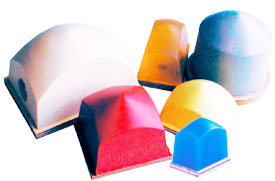

Prix FOB
Obtenir le dernier prix|
- Minimum Order
Pays:
India
N ° de modèle:
Sillicon rubber pads
Prix FOB:
Localité:
-
Prix de commande minimale:
-
Commande minimale:
-
Packaging Detail:
-
Heure de livraison:
-
Capacité de Fournir:
-
Payment Type:
-
Groupe de produits :
-
India
Personne à contacter Mr. Vineet
88, Pace City-1,Sec-37, Gurgaon, Haryana
Special **0 German Technology shore pads are available for best printing onto abrasive substrates and textured finishes. Though the function of the pad seems simple - to just transfer the image from the printing plate onto the substrate - it is subject to the same types of print-quality fluctuations if you don't choose the correct pad type and use it properly. Five key pad characteristics can affect the quality of the printed image: 1.shape 2.size 3.hardness 4.surface finish ***** Vary any one of these and the print quality will shift. You must take these factors into account when you plan the job and order pads from your suppliers. The shape of the pad largely determines how well the pad will achieve this rolling action. This makes shape the most important variable in selecting a pad. Most pad suppliers have hundreds of pad shapes in their standard inventory. But most are based on these three basic shapes * Round * Rectangular * Bar Hardness The hardness of the pad is normally determined by the amount of silicon oil used when the pad is molded. The harder the pad, the less silicone oil that was added. Four basic pad hardnesses are standard in the industry and cover most applications. Customs pad hardnesses are available. As a general rule, the harder the pad, the better the performance. However, a hard pad may be impractical in some applications, such as when using a low-power machine or printing onto a delicate item. Choosing the proper pad hardness for a job is a matter of experimentation and experience. Special **0 Shore pads are available for printing onto abrasive substrates and textured finishes. Two such applications include the turn-signal control arms and windshield-wiper control arms of automobiles, which are molded in glass-filled nylon. A heavy white ink is required, and the pad must resist the abrasive nature of the substrate. Special pads for large images In some situations, a large image area must be printed and the machine does not have the power to compress such a heavy pad in a smooth motion. Two solutions to this problem are available. The first is to use a pad with a hollow interior that provides the same surface hardness. This technique also reduces the cost of silicone rubber for such a large pad. The second option is a dual-hardness pad, where the core of the pad is made of a softer material and the outer layer is the harder rubber. Both methods can help, but the second produces a more stable pad. (A third option, of course, would be to use a different imaging process such as screen printing for larger image areas.) Quality control of pads Poor-quality consumables like pads can destroy the performance of the printing machine. When you receive pads from your supplier, its vitally important before accepting them to check the pads for: blemishes on the print surface foreign particles in the print surface, such as wood splinters "nipples" on the print surface firm attachment of the pad to the backing plate (The pad should be secure, with no air bubbles that will cause the rubber to come away from the base.) hardness within **0 Shore (using your durometer gauge) positioning on the backing plate (It should be concentric, with its vertical center line at a *0° angle to the backing.) height (This is particularly important in multiple-pad applications). Report any defects to your pad supplier immediately so that replacement pads can be furnished. Pad Handling Although no hard and fast guidelines regarding pad life are available, you can take a number of steps to get the most life from all your pads: Use a strong solvent only for initial removal of the silicone oil on the surface. Use a mild solvent such as alcohol, or preferably an adhesive tape, if the pad must be cleaned during production. Always use an adhesive tape to remove debris and dried ink before starting a production run. Don't use too much pad pressure. Ensure that the substrate is free of debris, particularly sharp particles, before printing. With wooden-backed pads, don't allow the mounting screws to penetrate the rubber. When possible, avoid printing near sharp substrate edges. Use as large a pad as is reasonable for the job. Never store a pad on top of another. If pads are supplied in a protective shell, use it when storing the pads in your shop. Handle and store the pads very carefully.
| Pays: | India |
| N ° de modèle: | Sillicon rubber pads |
| Prix FOB: | Obtenir le dernier prix |
| Localité: | - |
| Prix de commande minimale: | - |
| Commande minimale: | - |
| Packaging Detail: | - |
| Heure de livraison: | - |
| Capacité de Fournir: | - |
| Payment Type: | - |
| Groupe de produits : | - |